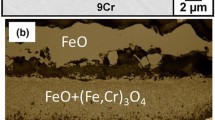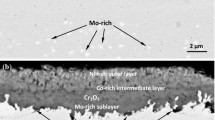Abstract
Scaling reactions between pure metals and multiple oxidant gases are reviewed briefly. It is recognized that elemental oxidant activities are usually so low that the actual reactant species are heteronuclear molecules such as SO2, CO2, etc. The formation of duplex, sulfide-oxide scales on iron and manganese, even when sulfide is unstable with respect to oxide, is attributed to direct reaction with SO2. The persistence of the metastable sulfide is due to its preservation by the rapidly growing scale. The reaction of pure chromium with a number of mixed gases is also discussed. The continued formation of carbides and nitrides beneath an external Cr2O3 scale layer indicates that the latter material is permeable to gas species. Interaction among different gas species is observed, and is attributed to selective adsorption on internal surfaces within the chromium oxide. New work on the reaction of alloys with mixed gases is reported. Several austenitic heat-resistant alloys were exposed at 1000°C to gases containing one, two or all of the oxidants carbon, sulfur and oxygen. Gases containing two or more oxidants produced multiple zones of internal precipitation. The precipitates were chromium-rich oxides, sulfides and carbides arranged in order of thermodynamic stability: oxides beneath the external scale, carbides deepest within the alloys and sulfides in an intermediate zone overlapping the oxide zone. Each precipitate zone widened according to parabolic kinetics. This finding confirms the as yet untested prediction made by J. L. Meijering in 1971. However, the rate at which a particular zone grows changes according to presence of other oxidants. Interactions between the oxidants can be large and reaction rates are currently not predictable.
Similar content being viewed by others
References
C. A. Snavely and C. L. Faust,J. Electrochem. Soc. 97, 99 (1950).
F. S. Pettit, J. A. Goebel, and G. W. Goward,Corros. Sci. 9, 903 (1969).
E. A. Gulbransen and S. A. Jansson, inProceedings of the Symposium on High Temperature Metallic Corrosion by Sulfur and its Compounds, Z. A. Foroulis, ed. (Electrochemical Society Inc., New York, 1970), Vol. 3.
N. Birks, inProceedings of the Symposium on High Temperature Gas-Metal Reactions in Mixed Environments, S. A. Jansson and Z. A. Foroulis, eds. (Met. Soc. AIME, New York, 1973), p. 322.
A. Rahmel,Corros. Sci. 13, 125 (1973).
A. Rahmel, inProceedings of the Symposium on High Temperature Gas-Metal Reactions in Mixed Environments, S. A. Jansson and Z. A. Foroulis, eds. (Met. Soc. AIME, New York, 1973), p. 284.
A. Rahmel,Oxid. Met. 9, 401 (1975).
P. Kofstad, inProceedings of the 8th Symposium on the Reactivity of Solids, J. Wood, O. Lindqvist, C. Helgesson, and N. G. Vannerberg, eds. (Plenum Press, New York, 1976). p. 15.
N. Birks, inProceedings of the Symposium on Properties of High Temperature Alloys, Z. A. Foroulis and F. S. Pettit, eds. (Electrochemical Society, 1976), Vol. N.77-1, p. 215.
W. F. Chu and A. Rahmel,Rev. High Temp. Mater. 4, 139 (1979).
F. Gesmundo,Oxid. Met. 13, 237 (1979).
W. L. Worrell, US-Japan Joint Seminar on Defects and Diffusion in Solids, 1979, p. 155.
C. S. Giggins and F. S. Pettit,Oxid. Met. 14, 363 (1980).
K. Natesan, inProceedings of the Spring Residential Conference on Environmental Degradation of High Temperature Materials, Series 3, (Institution of Metallurgists, London, 1980), Vol. 1, No. 13, pp. 1–12.
K. N. Strafford, inProceedings of the Spring Residential Conference on Environmental Degradation of High Temperature Materials, Series 3, (Institution of Metallurgists, London, 1980), Vol. 1, No. 13, p. 5–1.
S. Mrowec, in Proceedings of the 8th International Congress of Metallic Corrosion, DECHEMA, Frankfurt, Vol. 3, 1981, p. 2110.
N. Birks and G. H. Meier, inProceedings of the Conference on Corrosion-Erosion-Wear of Materials in Emerging Fossil Energy Systems, A. V. Levy, ed. (NACE, Houston, 1982), p. 1.
K. N. Strafford and P. J. Hunt, inProceedings of the International Conference on High Temperature Corrosion, R. A. Rapp, ed. (NACE, Houston, 1983), p. 380.
G. H. Meier, N. Birks, F. S. Pettit, and C. S. Giggins, inProceedings of the International Conference on High Temperature Corrosion, R. A. Rapp, ed. (NACE, Houston, 1983), p. 327.
F. Fueki and K. Fuda, in Proceedings of the 3rd JIM International Symposium on High Temperature Corrosion of metals and Alloys, Japan Institute of Metals, Sendai, 1983, p. 435.
H. J. Grabke, inProceedings of a Seminar on High Temperature Materials Corrosion in Coal Gasification Atmospheres, J. F. Norton, ed. (Elsevier Applied Science, London, 1984), p. 59.
D. J. Srolovitz and T. A. Ramanarayanan,Oxid. Met. 22, 247 (1984).
M. F. Stroosnijder and W. J. Quadakkers,High Temp. Technol. 4, 83 (1986).
M. F. Stroosnijder and W. J. Quadakkers,High Temp. Technol. 4, 141 (1986).
F. Gesmundo, D. J. Young, and S. K. Roy,High Temp. Mater. Process. 8, 149 (1989).
T. Flatley and N. Birks,J. Iron Steel Inst. 209, 523 (1971).
G. McAdam and D. J. Young,Oxid. Met. 37, 281 (1992).
G. McAdam and D. J. Young,Oxid. Met. 37, 301 (1992).
J. Unsworth and D. J. Young, University of New South Wales, unpublished research (1994).
K. Kurokawa, T. Narita, and K. Nishida, in Proc. 34d JIM Int. Symp. High Temperature Corrosion of Metals and Alloys, Japan Institute of Metals, Sendai, 1983, p. 465.
M. Danielewski and K. Natesan,Oxid. Met. 12, 227 (1977).
C. De Asmundis, F. Gesmundo, and C. Bottino,Oxid. Met. 14, 351 (1980).
H. Hindam and D. P. Whittle,Corrosion 38, 32 (1982).
M. LaBranche, A. Garratt-Reed, and G. J. Yurek,J. Electrochem. Soc. 130, 2405 (1983).
G. J. Yurek, M. H. LaBranche, and Y. K. Kim, inHigh Temperature Energy Systems, M. Rothman, ed. (Met. Soc. AIME, 1985), p. 295.
H. S. Hsu,Oxid. Met. 28, 213 (1987).
D. J. Baxter and K. Natesan,Oxid. Met. 31, 305 (1989).
X. G. Zheng and D. J. Young,Oxid. Met. 42, 163 (1994).
X. G. Zheng and D. J. Young,Corros. Sci. 36, 1999 (1994).
I. Wolf and H. J. Grabke,Solid State Commun. 54, 5 (1985).
R. G. Olsen and E. T. Turkdogan,Met. Trans. 5, 21 (1974).
H. J. Grabke,Mater. Sci. Eng. 42, 91 (1980).
J. Barnes, J. Corish, and J. F. Norton,Oxid. Met. 26, 333 (1986).
T. A. Ramanarayanan,Mater. Sci. Eng. 87, 113 (1987).
A. V. Seybolt and D. H. Haman,Trans. Met. Soc. AIME 230, 1294 (1964).
C. Wagner,Z. Elektrochem. 63, 772 (1950).
R. A. Rapp,Corrosion 21, 730 (1965).
J. H. Swisher, inOxidation of Metals and Alloys, D. L. Douglass, ed. (ASM, Metals Park, OH, 1971).
F. S. Pettit, J. A. Goebel, and G. W. Goward,Corros. Sci. 9, 903 (1969).
J. A. Colwell and R. A. Rapp,Met. Trans. A 17A, 1065 (1986).
C. J. Spengler and R. Viswanathan,Met. Trans. 3, 161 (1972).
J. L. Meijering, inAdvances in Materials Research, 5th ed., H. Herman, ed. (Wiley-Interscience, New York, 1971).
S. K. Bukovinsky, K. R. L. Thompson, and D. J. Young, Proc. Annual IMMA Conference, vol. 2, paper 11-1, Inst. Metals and Materials Aust., Melbourne, 1990.
S. Watson, P. Munroe, and D. J. Young, University of New South Wales, unpublished research (1994).
K. Tjokro, D. J. Young, R. E. Johanssen, and J. D. Redmond, Corrosion 91, paper 548, NACE, Houston, TX, 1991.
T. Wada, H. Wada, J. F. Elliott, and J. Chipman,Met. Trans. 2, 2199 (1971).
S. K. Bose and H. J. Grabke,Z. Metall. 69, 8 (1978).
C. Wagner,Thermodynamics of Alloys (Addison-Wesley, Reading, MA, 1952), p. 51.
Author information
Authors and Affiliations
Rights and permissions
About this article
Cite this article
Young, D.J., Watson, S. High-temperature corrosion in mixed gas environments. Oxid Met 44, 239–264 (1995). https://doi.org/10.1007/BF01046729
Received:
Issue Date:
DOI: https://doi.org/10.1007/BF01046729




